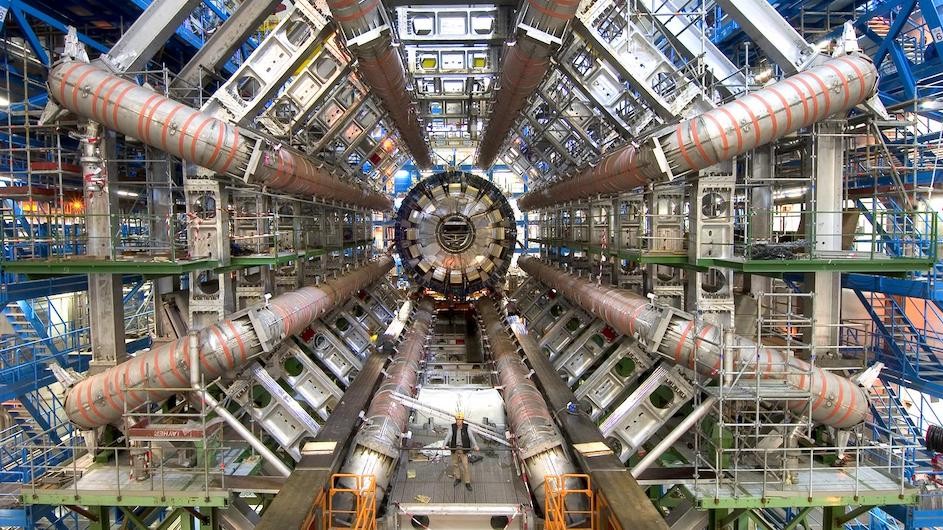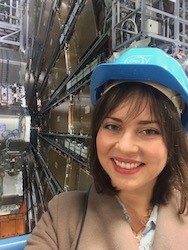Exploring the Wonders of High-Energy Particle Experiments
On April 18, Julia Gonski, a postdoc, will deliver a public talk on new research in particle physics.

Next Tuesday, April 18, at 7:00 pm, postdoctoral research scientist Julia L. Gonski will deliver a talk at Columbia’s Nevis Science Center in Irvington, New York, about planned upgrades to the Large Hadron Collider at the CERN lab in Switzerland, the world’s largest particle accelerator. The talk, “On the Shoulders of ATLAS: Upgrading the World’s Highest Energy Particle Experiment,” is the latest installment in Science-on-Hudson, a series of spring lectures held at Nevis. Columbia News caught up with Gonski to talk about what the Collider can tell us, what the work in Switzerland has to do with her research, and what's the best place to grab a pre-talk dinner in Irvington.
What will the subject of this talk be?
I'll be speaking about the ATLAS experiment, a 7,000-ton particle detector that sits underground on the Large Hadron Collider at the CERN laboratory in Geneva, Switzerland. The Large Hadron Collider rose to Nobel Prize-winning fame in 2012, when its detectors reported the first observation of the Higgs boson particle, which is believed to play a central role in giving particles their mass. The discovery of the Higgs boson launched the field of high energy physics into a new era, and we are preparing for the future by building new and improved detectors for data collection. Lots of the research and development for these advanced detector systems is happening right here at Nevis, so I'll be sure to give a particular shout-out to all the exciting local activity.
Why did you want to give this talk?
The short answer is that I think particle physics is incredibly cool and worth talking about! I've been working on Large Hadron Collider experiments since my freshman year of college, and I've always enjoyed presenting this work to people outside of the field. For one, I have a firm belief that federally funded research should be accessible and exciting for everyone, since the results that come out of this work are a public resource. Beyond that, I've found that some of the most insightful questions can come from new and fresh perspectives! Too many of us think of physics only as the tough subject in high school (and on this I'm with you), but in reality there's so much more to it.

What do particle accelerators allow us to observe, in general?
Particle accelerators give us a peek into the fundamental nature of the universe by allowing us to recreate the environment when it first began, less than one nanosecond after the Big Bang. The universe at that time was much hotter due to its smaller volume. Some very heavy fundamental particles were around that have since effectively "frozen out" as the universe has expanded. We put energy into particle colliders with the goal of producing the very massive particles that were abundant in the early universe in a collision interaction. Each time we collide two particles, it's a roll of the quantum dice that determines what interaction could occur. The key here is the famous E=mc2: The more energy we put in, the more likely we are to get one of those very massive rare particles. These relics from the Big Bang are the blueprint to understanding how physics evolved the universe into what we see today.
The Large Hadron Collider is being turned off to be upgraded in the next few years. When it reopens, it will be able to collide particles at a rate 10 times faster than its current rate. What is the most exciting possibility that this opens up for research?
The push to higher rate (or "luminosity" in collider terms) is based on the fact that high energy particle research is a numbers game: We have no guarantees of which collision might successfully produce a rare never-before-seen particle, so we need quadrillions on quadrillions (yes, seriously) of collisions to get the data we want. Examples of what we're after include the elusive particle that makes up dark matter, material that we can't directly observe but we know is creating gravity in the universe, or extremely precise measurements of the Higgs boson and its properties.
As a physics postdoc, what do you spend most of your day doing?
Being a postdoc in physics often feels like several totally different jobs all rolled into one. The core activity of our research is data analysis, so there's a lot of coding day-to-day. At Columbia's Nevis Labs, we have physical setups of various electronic chips and boards that we're developing, so those require some hours sitting in the lab testing and debugging. High energy colliders are unique in that there are thousands of people all working on the same project, so being a postdoc on these experiments also comes with some organizational and leadership responsibility. In this respect a lot of my time is spent on the phone with colleagues or discussing ideas with students, which is often the most productive and exciting part of the day!
I'm taking the train up to Irvington to see the talk. Where should I grab a bite to eat beforehand?
In the Nevis group we've done our share of lunch runs and even occasional delivery if we're at the lab late, so we have lots of good recommendations! Scaperrotta's Deli is a favorite for sandwiches, but it’s only open from early morning to late afternoon. If you have some free time before the talk, check out Climbing Wolf, which is a really nice place to grab coffee or drinks.
Gonski’s talk takes place on April 18, at 7:00 pm, at Nevis Science Center, South Broadway, Irvington, NY 10533. Registration is required. On May 23, Carl Haber will deliver another Science-on-Hudson Lecture, “Seeing Voices: Using Light to Restore and Preserve Early Recorded Sound.”